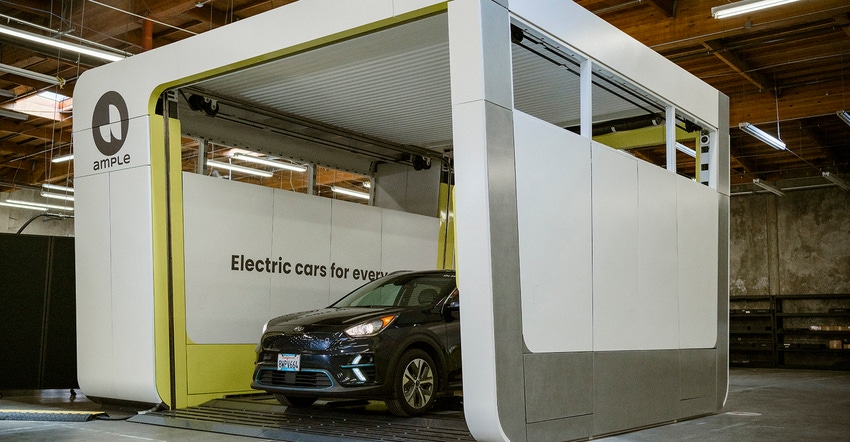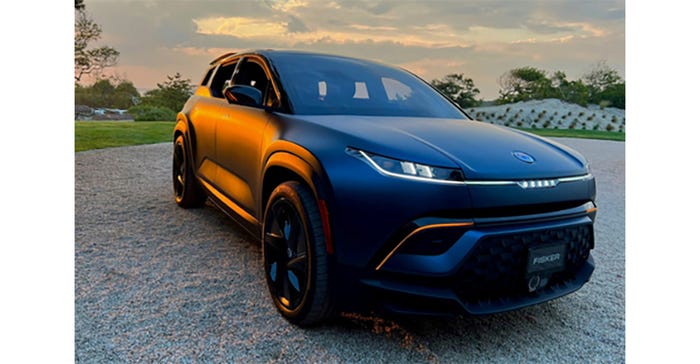Swappable battery startup Ample’s new system exchanges batteries in five minutes; its new state and corporate agreements could help mainstream the practice.

Battery swapping for EVs has been an appealing idea in the abstract: it’s just that the stubborn reality of competitive battery and charging designs has made it impractical.
The appeal: A major hurdle in getting the public to embrace vehicle electrification is the length of time it takes to recharge an EV battery—it’s been hours, in contrast to the few minutes it takes to top off a gas tank. Battery swapping gets around that.
Unfortunately, as EV makers use proprietary, non-standardized batteries—each of which is much larger and more cumbersome than, say, e-bike batteries which are proving more amenable to swapping networks—automotive battery-swapping hasn’t proven practical. Tesla, for example, opened a single battery swap station in California in 2014 but discontinued the initiative—Elon Musk termed it unworkable—in favor of expanding its Supercharger network.
Ample opportunity for mainstreaming EV battery swapping
But that may change. Ample, a California startup specializing in battery swapping, is introducing its next-generation automated swapping station that cuts the swapping process time to around five minutes—comparable to the time it takes to refuel a gas tank, and much less than the 30 minutes or more required to recharge most EVs at public fast-chargers.
Ample’s news blog describes a San Francisco-area Uber driver’s recent experience at a swap station: “Approaching the Ample station, the car is recognized by the station, and its door is automatically raised. Once perfectly parked inside, the driver initiates the swap from the Ample app on her phone. Five minutes later, the driver is back on the road resuming her workday.”
The company says that the swapping stations’ “new streamlined drive-through design is more user-friendly, safer, and more delightful. A whole platform that raises the car allows passengers to come in and out of the car as a swap is in progress.”
Ample emphasizes that the swapping stations are not only easy to use but also that they’re easy to install—being able to be put in place in just three days: “We deliver the station in a few pre-built sections to where a station will go up, and those are put together on-site, further simplifying the installation. And like our first-generation technology, deploying a station requires no digging. To support different demand levels at different locations, stations can be easily stacked so multiple vehicles can swap simultaneously at the same location.”
Modular battery packs—and industry buy-in—required
The swapping system depends on Ample-made modular battery packs that can be integrated into EVs of varying sizes—including large delivery trucks—allowing for easy swapping when depleted. The compact modules fit within an adapter plate designed to match the shape and size of the original battery in each vehicle.
This flexibility enables car manufacturers to offer Ample's swappable battery as an optional feature during the manufacturing process.
And one manufacturer is taking Ample up on the opportunity: On May 2, EV maker Fisker Inc. announced a partnership with Ample, through which Fisker’s Ocean SUV will have Ample-provided battery modules.

The initial target customer for Fisker’s Ample-powered EVs will be fleet operators who are looking to transition to electric mobility without economic or operational compromises, according to the announcement: “Ample's technology makes it possible to rapidly deploy EV infrastructure so that Fisker can make its vehicles available to larger markets on a faster timetable.” The two companies will share revenue related to the battery swapping mechanism.
“Our partnership with Ample will enable us to broaden the vehicle use case for our customers,” Henrik Fisker, Chairman and CEO of Fisker Inc. stated. “We’re thrilled to offer Ample’s innovative battery-swapping system, which will bring a new level of affordability to the Fisker Ocean and potentially to the other vehicles we intend to bring to market in the future.”
California’s investment
Not only manufacturers but also governments, eyeing infrastructure needs and carbon-neutrality goals, would need to buy in if EV battery swapping is to become a genuine movement.
One state government, that of California, is willing to test the waters. In February, the California Energy Commission awarded a $15M grant to Ample to support the expansion and operation of Ample’s automated battery module production facility in Brisbane, CA, which is expected to produce swappable battery packs for about 14,400 vehicles per year.
Whether any other state—particularly ones, unlike Califoria, who can’t expect to see Ample battery factories within their borders—show interest in investing in the company’s swapping-station network remains to be seen.
Still, by putting money and resources on the line, Fisker and California are enabling a fresh look at EV battery swapping—a scheme that seemed all but moribund a few years ago.
Editors note: We recently looked at other battery-swapping ventures around the world: That article is here.
About the Author(s)
You May Also Like





